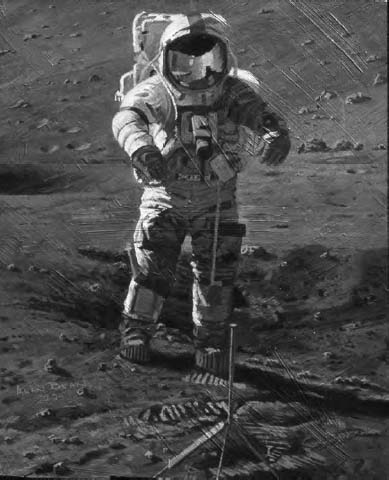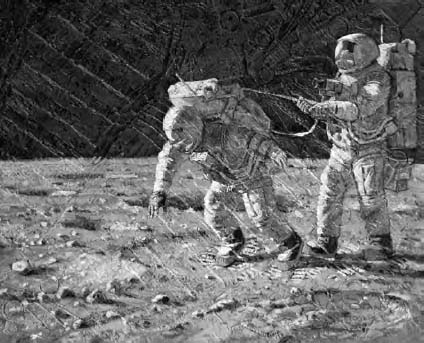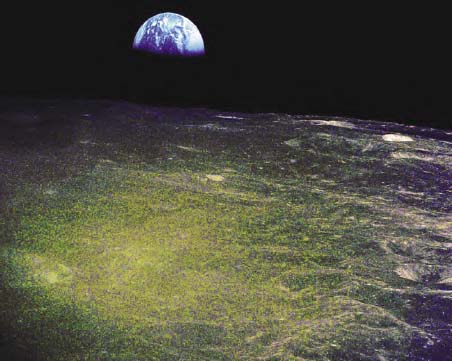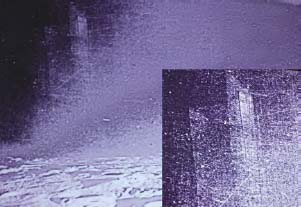Ancient Aliens on the Moon (14 page)
Read Ancient Aliens on the Moon Online
Authors: Mike Bara

NASA frame AS17-137-20990. In the color version, orange soil in the foreground is caused by iron oxidation in the soil, not from overhead prismatic effects. There are purple and pink rocks and mountains in the background of the color version of this photo.
And the experiment was repeatable, using downloaded versions of NASA own scans of their archived images. Everywhere we looked, the Moon became a colorful, interesting place.
This also explains the earlier
Surveyor
images that came back inexplicably colorful. Without knowing it, NASA had landed beneath a virtual sea of glass prisms which turned the lunar surface into a kaleidoscope of colors.
But again, this brings back the question of just how the astronauts could have missed all this. The short answer is they didn’t. At least not one of them.
Alan LaVern Bean was the Lunar Module Pilot for the Apollo 12 mission and the fourth human being to walk on the surface of the Moon. After returning from the Moon, he later flew on one of the Skylab missions and then retired from NASA in 1981 to devote his life to painting. Along the way, he made paintings of his experiences on the Moon with Pete Conrad on Apollo 12.

Self portrait of Alan Bean on the lunar surface. It has the exact color match for the Apollo 17 photos of yellows and reds.
At first, these paintings depicted the lunar surface as we had all been told it was; bland and grey and colorless. But he then began to rethink his work, and as he did so, the images got more and more colorful until eventually they matched not only the colorful images we now see under enhancement, but the far-distant structures as well.
One of Bean’s paintings, “Rock and Roll on the Ocean of Storms,” not only shows the distinct pink and blue colored lunar surface, it also shows lines in the sky that are eerily reminiscent of the “inclined buttress” structures seen in both the Apollo 14 photography and the Apollo 12 16mm film.
Now, these angled lines are actually the imprint of a moon boot that Bean puts on all of his paintings of the Moon, but there is no doubt that the placement of it and effect it has recalls the slanted structures seen in the Apollo images.
But these paintings all raise the question of just how well Bean truly remembers what he saw on the Moon. The fact that he was dissatisfied with the depictions that showed the lunar surface to look like the official NASA version is telling. His need to add color to the Moon’s surface in his paintings (“I had to figure out a way to add color to the Moon without ruining it,” he is quoted as saying) is also telling. Why? Maybe because there was something naggingly wrong with Moon as NASA chooses to depict it. Because of this, I think it is possible that Bean, like many of the other astronauts, has a hard time remembering what he saw and did on the Moon. There have always been rumors that the astronauts were hypnotized during their technical debriefings to “help them remember.” Given Bean’s apparent struggle with getting his artistic depiction of the Moon “right,” I tend to think this is likely.

“Rock and Roll on the Ocean of Storms” by Alan Bean.
I also take Bean’s paintings as independent verification that the lunar dome hypothesis is correct, and that the Moon is far more colorful than we’ve been led to believe.
Which brings us to the first question; could the astronauts have simply missed seeing these towering lunar structures?
Again, the short answer is no. While the astronauts had filters on their helmets to supposedly help block out ultraviolet rays, these filters would most likely have helped, rather than hindered their ability to “see” the towering glass ruins in the distance. These ultraviolet filters were gold screens (similar to those used on fighter planes today) that could be slid down over the visors. These gold filters had the effect of actually
enhancing
light in the blue end of the visual spectrum, and we know that these enormous structures (due to a phenomenon called Rayleigh scattering) tend to shift light into exactly that same end of the color spectrum. So if anything, the gold visors would have made it easier to see the distant glass structures, not harder.
And there is one other piece of evidence that supports the idea that NASA had a pretty good idea about the lunar domes before they ever sent men to the Moon—the landing of Apollo 11.
By now, we’ve probably all seen the dramatic footage over and over again; the tense mission control engineers, the drama of Edwin “Buzz” Aldrin calling out the dwindling fuel resources, Neil Armstrong having to take over the controls manually to clear a field of boulders, and the scary “1202” alarm that no one could figure out. And then finally the dramatic “The Eagle has landed,” call from Tranquility Base and the relief from “a bunch of guys about to blue” in Mission Control in Houston. But in reality, there is something far more telling about Eagle’s dramatic descent to the lunar surface; what caused the “1202” alarm in the first place?
We now know, thanks to outlets like NASA TV and the History Channel, that the 1202 alarm was a computer overload alarm. A modern cell phone has thousands of times the computing power that the Lunar Module did on that fateful day in 1969, so it might seem like overloading such a primitive computer was fairly easy to do. Not so. In fact, the 1202 computer alarm was so rare that it had not ever even come up NASA’s landing simulations prior to the Apollo 11 landing. When it happened and the computer reset, Armstrong called back to Mission Control for an interpretation and was preparing to abort the landing if he didn’t get the answer he wanted. In fact, according to Aldrin, he actually had his hand on the abort trigger while they waited for word from NASA as to the nature of the warning.
As it turns out, the reason for the 1202 alarm was that there were too many systems active on the Eagle and too much data was coming in. This was because Aldrin had done something he was not supposed to do; he turned on two different radars.
Unbeknownst to most people, the Lunar Module was equipped with two different radar systems, a landing radar and rendezvous radar. The landing radar was (obviously) downward looking and the rendezvous radar was side looking. According to the checklist, Aldrin was only supposed to activate the landing radar, but instead he activated both the landing radar and the rendezvous radar. As a result, the computer was overloaded with data and had to shut down and reset, hence the dramatic “1202” alarm.
1
But the big question is why would he do this? If the Moon is exactly as NASA portrays it, then there is no need for anything but the landing radar. There are no towering glass structures to worry about hitting, so all you need to know is your altitude above the landing site. Since the Apollo 11 landing site was in virtually the middle of nowhere in the Sea of Tranquility, with no mountains around the flat plain for hundreds of miles, there was no need to worry about getting too close anything on the way down. But if Aldrin
knew
there were transparent, immense structures all over the Moon, then activating the side-looking rendezvous radar would have been a natural precaution.
So the next question is fairly obvious as well; if there are glass ruins on the Moon, where exactly is the rest of it located? As we’ll see, it’s all over the place. But one of the most interesting regions is someplace we never even landed—Mare Crisium.
1
E-mail communication from Ken Johnston Jr. to the author. July 2, 2004.

Close-up of NASA color image AS16-120-19187 showing blue-shifted glass structures obscuring view of Earthrise.

NASA color image AS16-120-19187, showing glass-like intervening medium obscuring the lunar landscape.

4 different versions of AS14-66-9301 showing glass ruins over the horizon. (NASA)

Geometric glass structures over Sinus Medii from NASA image AS10-324816.

